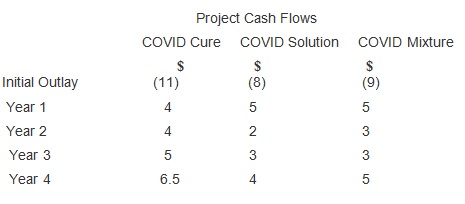Carefully analysis the question below
Question 1
Gloven pharmaceuticals a leading global pharmaceutical company is considering investing in some equipment to produce a localized vaccine named COVID cure to help combat the Covid-19 pandemic. The new equipment’s capital cost is estimated at $100 million. If its purchase is approved now, the equipment can be bought and production can commence by the end of this year. $50 million has already been spent on research and development work. Estimates of revenues and costs arising from the operation of the new equipment appear as follows:
If the equipment is bought, sales of some existing Covid-19 products will be lost, resulting in a loss of contribution of $15 million a year, over the life of the equipment. The accountant has informed you that the fixed cost includes depreciation of $20 million a year on the new equipment. It also includes an allocation of $10 million for fixed overheads. A separate study has indicated that if the new equipment were bought, additional overheads, excluding depreciation, arising from producing the chemical would be $8 million a year. Production would require additional working capital of $30 million. For the purposes of your initial calculations, ignore taxation.
Required:
Write a publishable research paper to an International Journal using Harvard Referencing style to respond to the questions below:
a. With appropriate practical illustrations identify and discuss the investment appraisal process the company should embark upon in the investment decision process.
b. With reference to (a) above at what stage should the project be evaluated and explain two methods usually considered best techniques in assessing investment opportunities and provide reasons why one technique will be superior for the pharmaceutical company to adopt.
c. Discuss four non-quantifiable benefits you can identify for such investments to recognizable stakeholders of the business in the paper.
d. Deduce the relevant annual cash flows associated with buying the equipment and
(i) Calculate the payback period.
(ii) Calculate the net present value using a discount rate of 8 per cent.
(Hint: You should deal with the investment in working capital by treating it as a cash outflow at the start of the project and an inflow at the end.)
e. Assuming the pharmaceutical giant is considering three vaccines but with limited funds with the expected pattern of cash flows for each vaccine is as follows:
The company has a cost of capital of 12 per cent and the investment budget for the year that has just begun is restricted to $12 million. Each vaccine is divisible (that is, it is possible to undertake part of a vaccine if required).
Which vaccine(s) should the business invest in and why?
f. If Gloven pharmaceuticals decision makers fail to take account of inflation in the investment decision will it matter given that, in recent years, the level of inflation has been low? What would be the effect of dealing with inflation incorrectly on NPV calculations (that is, would NPV be overstated or understated) by
(i) Discounting cash flows that include inflation at real discount rates and
(ii) Discounting real cash flows at market discount rates that include inflation?
g. What is risk in this investment and to what extent can it be diversified away when making investment decisions?





